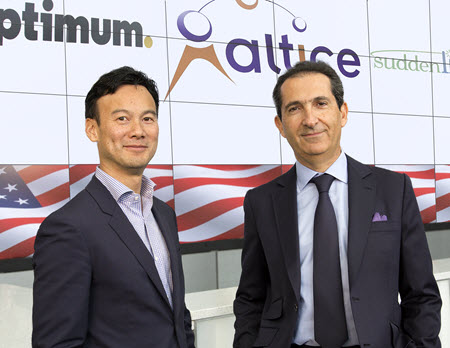Altice USA Rides High After Split

Altice USA stock, weighed down by the enormous debt load of its parent, European telecom stalwart Altice N.V., is getting some needed relief in the form of a spinoff that should remove at least some of the shackles that have restrained the shares since the company’s June IPO.
Altice N.V. announced its plan to complete the split from the U.S. division by the second quarter. As part of the deal, Altice USA will issue a $1.5 billion dividend, which will mainly fall to the Altice N.V. shareholders that own about two-thirds of the U.S. unit. After the deal is closed, the European operation will be renamed Altice Europe and be led by current Altice N.V. chief financial officer Dennis Okhuijsen, rising to CEO. Former CEO Michel Combes left the company in November and was named president and CFO of Sprint earlier this month.
Altice USA CEO Dexter Goei and his team will remain in their current roles after the closing. And Altice founder Patrick Drahi will remain in control of both companies, serving as president of Altice Europe and chairman of Altice USA.
The separation should remove one of the biggest overhangs on Altice USA stock — its parent’s heavy debt load and uncertainty surrounding the European telecom market. Altice USA went public in June 2017 at $30 per share and enjoyed a strong run-up in the days after the IPO, rising as high as $34.30 per share by June 23. But concerns over that heavy debt — about $55 billion — and competitive issues over its wireless business in France negatively affected the U.S. stock. Altice USA finished the year down about 35% ($11.48 each) to $21.23 per share.
Investors appeared pleased with the split, driving Altice USA shares up 9.6% Jan. 9 to $23.11 each.
Taking the Long View
While the split was expected to remove much of the onus on the U.S. stock, Goei, in a conference call with reporters after the transaction was announced, said short-term market reaction is not one of the company’s biggest priorities.
“We feel we’ve positioned the U.S. stock and the European stock to perform to the best of its abilities and to reflect appropriately the value that the respective business should be valued at relative to its peers,” Goei said. “Let’s see how the market reacts, but this is obviously not a short-term thing we are doing today.”
In a research note, Jeff Wlodarczak, Pivotal Research Group CEO and senior media & communications analyst, wrote that the spin solves a lot of problems for the U.S. operations. It not only removes concern that the U.S. business may be pressed into shoring up the European operations (particularly in France), but also simplifies the structure and boosts the U.S. stock’s public float from 10% of outstanding shares to 42%, which should attract a wider swath of investors and free the company to return capital to shareholders through more aggressive buybacks.
Altice USA said that as part of the separation, it plans to buy back about $2 billion of its stock over the next three years.
But this plan doesn’t solve everything quite yet. Despite a management pledge to reduce leverage targets from 5.0-to-5.5 times cash flow to 4.5-to-5.0 times, initially the deal will increase debt at the U.S. company to about 5.8 times cash flow.
That added debt and the overall climate around deals means it is unlikely that Altice USA will embark on any buying spree — one of the early reasons to buy the stock — anytime soon.
“I don’t think we are there yet in terms of thinking about where our acquisition strategy could be,” Goei said on the reporters’ call. “I think this is an important moment for the group to focus on our existing operations and deliver on what we’ve promised in our respective geographies in Europe and the U.S. Over time, we suspect that the clarity and simplicity of our structure will help our investor base be supportive in things that we may want to do going forward.”
But he hinted that M&A isn’t totally out of the picture. “The DNA of the group is to try and grow strategically over time, but it is clearly not a focus today,” he said.
New Commitment to U.S. Arm
For now, the deal appears to further solidify Altice’s commitment to the U.S. operation. Problems at its European unit began to surface in November, when a big earnings shortfall at the company’s French wireless operations spooked investors, sending the European stock into a tailspin. For U.S. investors, the French unit’s failures signaled possible flaws with the domestic model, and the possibility that the U.S. business would be pressed to bail out its parent.
And though many analysts were skeptical of Altice’s cost-cutting ambitions — when it bought Cablevision in 2016 it pledged to shave $900 million in expenses, a move many believed would eviscerate the company — it has so far kept its promise. In Q3 Altice USA said its run-rate non-programming efficiency savings were more than $900 million since the Cablevision purchase.
In a research note in November, MoffettNathanson principal and senior analyst Craig Moffett noted that per-subscriber programming costs increased between 6% and 7% at Altice USA, almost half the 12.7% increase at much larger Comcast in the period. While Altice said it expects future programming-cost increases in the high single digits, Moffett added that Altice has captured much of the efficiencies it promised already, and there is no reason to believe more won’t come.
“With margins still rising rapidly, both [year-over-year] and sequentially, it doesn’t appear they are done yet,” Moffett wrote in the report.
Multichannel Newsletter
The smarter way to stay on top of the multichannel video marketplace. Sign up below.
